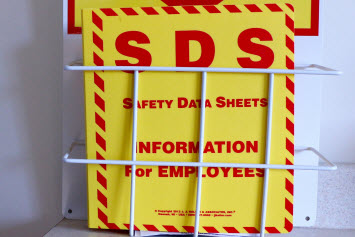In 2012, OSHA completed a comprehensive revision of its Hazard Communication Standard (HCS) with the general objective of achieving alignment with the United Nations’ (U.N.) 2009 Globally Harmonized System of Classification and Labelling of Chemicals (GHS). The revision provided much needed improvements in how information about hazardous chemicals in the workplace is communicated to employees, but there remain questions about implementation of the HCS and particularly about one of its critical components—safety data sheets (SDSs).
For example, in a recent letter of interpretation (LOI) to a company that provides worldwide services related to the HCS and similar international programs, OSHA’s Directorate of Enforcement Programs answered questions about the applicability of the HCS and the SDS requirements to imported products. The company’s main question concerned the degree to which SDSs can include information and be formatted to meet both OSHA’s HCS requirements and the requirements of Health Canada’s Hazardous Products Regulations (HPR) and its Workplace Hazardous Materials Information System (WHMIS). The LOI also addresses whether a company contracted to develop SDSs for a chemical manufacturer or importer may be a liable party with regard to meeting the HCS requirements. While the letter covers these and other aspects of SDS requirements, OSHA’s main point seems to be that additional information can be included in hybrid SDSs as long as it does not “contradict or cast doubt” on the information required in SDSs.
Background
OSHA issued the original HCS in 1983. Chemical manufacturers and importers were required to evaluate the chemicals they produce or import and provide hazard information to downstream employers and employees by putting labels on containers and preparing material safety data sheets (MSDSs). Information that was mandatory in MSDSs included the properties of each chemical; the physical, health, and environmental health hazards; protective measures; and safety precautions for handling, storing, and transporting the chemical.
Perhaps the major problem with the 1983 MSDS requirement was that it was performance-based. While certain information about the chemicals and their hazards was mandatory, there was no requirement that the information had to be provided in a specific format. Accordingly, chemical manufacturers and importers conveyed the required information in MSDSs and on labels in whatever format they chose. Manufacturers were also required to evaluate the potential hazards of chemicals, a vague word that resulted in more information disparities among MSDSs. The result was that employers were forced to continually relearn how to read and understand MSDSs that were dissimilar in how they presented data and described hazards.
In its 2012 final rule, OSHA revised the HCS to conform to the U.N.’s GHS (Rev. 3, 2009). The revisions included adoption of the GHS’s standardized format for MSDSs. To differentiate from the original HCS, OSHA introduced a new term for the new format—safety data sheet (SDS). The information required in SDSs was largely the same as what was required in MSDSs. But the new format (which chemical manufacturers had already been using for years on a voluntary basis) comprises 16 sections in a specific order of presentation. Items of primary interest to exposed employees and emergency responders are presented at the beginning of the document, while more technical information is presented in later sections. Also in line with the GHS, the revised HCS requires that chemical manufacturers and importers provide their chemicals with labels that include harmonized signal words, pictograms, and hazard statements for each hazard class and category. Precautionary statements must also be provided.
“The modifications to the HCS will significantly reduce burdens and costs, and also improve the quality and consistency of information provided to employers and employees regarding chemical hazards by providing harmonized criteria for classifying and labeling hazardous chemicals and for preparing safety data sheets for these chemicals,” OSHA stated in the preamble to the revision.

U.S. and Canada Signed MOU
All this brings us back to OSHA’s LOI. As noted, the thrust of the letter was to determine how information in SDSs required by Canada’s WHMIS can be incorporated into or is interchangeable with information in SDSs required by OSHA’s HCS.
Cooperation on this issue has already been addressed by the two nations. For example, in June 2013, OSHA and Health Canada signed a memorandum of understanding (MOU) to formalize implementation of the GHS in ways that reduced differences between the two jurisdictions and to build a common approach to future changes of the GHS (see OSHA memo). Also, in May 2015, OSHA announced that it would continue its partnership with Health Canada to align the U.S. and Canadian regulatory approaches regarding labels and SDSs and classification requirements for workplace chemicals.
“Where an SDS element is required by Health Canada’s WHMIS, and not by OSHA’s Hazard Communication standard, it is permitted/allowed by OSHA, unless the information would contradict or cast doubt on the required information,” the memo states. “Similarly, an SDS element that is required under HCS 2012 is permitted in Canada. An example applies to carcinogenicity. The HCS 2012 requires that if a chemical is identified as a carcinogen by OSHA, the International Agency for Research on Cancer (IARC), or the National Toxicology Program (NTP), then this information must be disclosed in SDS section 11, Toxicological information. Health Canada permits this information on the SDS even though under WHMIS the IARC and NTP listed carcinogens are not required to be disclosed on the SDS. However, if an SDS from Health Canada is sent to the U.S., the SDS must disclose information on any OSHA, IARC and NTP listed carcinogens.”
Avoiding Confusion
Points made in the LOI include the following.
- Section 1 of the SDS must include the name, address, and telephone number of the manufacturer, importer or other responsible party. (The HCS defines responsible party as “someone who can provide additional information on the hazardous chemical and appropriate emergency procedures, if necessary.” A responsible party may also be a partnership, association, corporation, business trust, legal representative, or any organized group of persons. These parties automatically become the responsible party.)
- Section 1 must also include an emergency phone number. “The address must be in the United States, and the phone number must be a domestic number,” states OSHA. “If a manufacturer, importer, distributor, or employer chooses to add a foreign address to an SDS, it may be listed in Section 1 if the responsible party believes they may be able to provide additional supplemental information and it is done in a fashion that does not cause confusion. To avoid confusion, the supplemental information may instead be provided in Section 16 of the SDS.”
- The party or importer that receives the chemical shipment from a foreign supplier is liable for all HCS 2012 requirements for that chemical, including classification and developing an SDS as soon as it is in the importer’s possession. If the chemical arrives at the facility without an SDS, the importer must create an HCS-compliant SDS. If the shipment arrives at the facility with an HCS 2012-compliant SDS, the importer may use that SDS to meet the HCS requirement.
- lf the chemical will not be leaving the facility, the U.S. importer may follow the workplace labeling requirements at 29 Code of Federal Regulations (CFR) 1910.1200(f)(6), which provide several options not available when chemicals leave the workplace.
- Health Canada’s 2015 WHMIS regulation does not require an importer to include its address on its SDS for chemicals to be used on-site. OSHA’s HCS does require that all SDSs must include a U.S. address in Section 1 of the SDS. OSHA says it does not currently plan to change this requirement.
- A contracted company that provides additional information for a hazardous chemical may be an SDS author or contracted preparer. In this arrangement, a manufacturer or importer may agree to list the contracted company on its chemical label and SDS as the party to be contacted to provide additional or emergency information. However, the manufacturer or importer remains the responsible party and, as such, maintains the ultimate responsibility for compliance with OSHA’s HCS. The contracted party may not claim responsibility for the SDS and its contents.
- Hybrid labels and SDSs that contain all the required HCS elements may include foreign country information as long as no information contradicts any requirement in OSHA’s HCS.
- A responsible party may follow the most recent version of the GHS as long as the hazard information does not contradict or cast doubt on the HCS 2012 required information. If the hazard and precautionary statements in Canada’s HPRs differ from 2012 HCS statements because they were adopted from a more recent revision of the GHS, the responsible party may use them as long as the hazard information does not cast doubt on the HCS 2012 required information. Minor differences are acceptable. (See OSHA Standard Interpretation at https://www.osha.gov/laws-regs/standardinterpretations/2017-11-29.) However, classification or hazard categories may be different in a more recent version of the GHS than in HCS 2012. In these cases, it is not permissible to use the hazard and precautionary statement from the more recent revision of the GHS because it would contradict or cast doubt on HCS required information.
- The HCS requires inclusion of health hazards not otherwise classified (HNOCs) in the SDS. Also, HNOCs may be included on the label as supplemental information. Additionally, OSHA permits the use of the exclamation mark pictogram to indicate the hazards of an HNOC on the label and SDS if the label also indicates that the pictogram is being used for an HNOC. However, the exclamation mark pictogram may appear only once on a label; if it already appears as a required pictogram for a classified hazard, it may not appear a second time as supplemental information for the HNOC.
- Canada’s HPR requires the use of precautionary statements for hazard classes not covered by the GHS. These hazard classes are combustible dusts, simple asphyxiants, pyrophoric gases, physical hazards not otherwise classified (PHNOC), and biohazardous infectious materials. The question was whether OSHA would allow the hybrid SDS to add precautionary statements for hazard classes not covered by the GHS. OSHA responded that while it does not require precautionary statements for HNOCs, it permits them as supplemental information as long as the statement does not contradict or cast doubt on the requirement information. HCS 2012 requires hazard statements for combustible dust, pyrophoric gas, and simple asphyxiants but does not require precautionary statements for those hazards.


